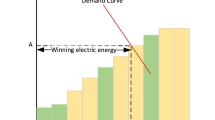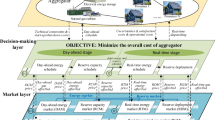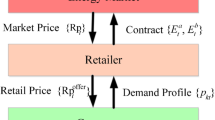Abstract
To control the uncertain risk of source–load interaction, this paper proposes a distributionally robust equilinear model of the power market clearing considering the carbon permit allocation. Firstly, a novel bi-level market-clearing framework that considers the allocation of carbon emission rights is proposed to coordinate energy trading between system operators and load aggregators in the market trading mechanism. Then, based on the conditional value at risk (CVaR) and distributionally robust (DR) theories, a risk avoidance expression and its equivalent convex form for the power constraint under the load aggregators are designed to address the risk of load uncertainty in load aggregators, revealing the underlying mechanism of risk avoidance under the DR CVaR power constraint. By leveraging the characteristics of a normal distribution and the Karush–Kuhn–Tucker condition, the proposed nonlinear bi-level DR CVaR market-clearing model is transformed into an efficient single-level linear model, resulting in reduced model solving difficulty, computational time, and resource consumption. Finally, the simulation of the case shows that the DR CVaR market-clearing model and the equilinear model can realize efficient allocation and complementary optimization of flexible resources in the market environment and improve the operation economy and stability of the power system.






Similar content being viewed by others
Abbreviations
- CVaR:
-
Conditional value at risk
- DR:
-
Distributionally robust
- LA:
-
Load aggregator
- KKT:
-
Karush–Kuhn–Tucker
- KL:
-
Kullback–Leibler
- RO:
-
Robust optimization
- SP:
-
Stochastic programming
- |⋅|:
-
Number of elements in “⋅”, if “⋅” is a set
- [⋅] + :
-
Max (0, ⋅)
- i :
-
Index of conventional units
- t :
-
Index of time slot
- EQ :
-
The expectation of probability measure Q
- N:
-
Set of all units
- \({\text{N}(\text{E}}_{0},{\Sigma }_{0})\) :
-
Empirical probability distribution of historical data
- T:
-
Set of all hours
- S TP :
-
Set of periods, and |STP|= T
- \({\mathbb{D}}\) :
-
Set of all probability distributions
- \({\mathbb{Q}}\) :
-
The ambiguity set is based on the KL divergence
- \({a}_{i},{b}_{i},{c}_{i}\) :
-
Coefficients of the production cost function of unit \(i\)
- \({a}_{\text{DG}},{b}_{\text{DG}},{c}_{\text{DG}}\) :
-
Cost coefficient of distributed generation
- \({\sigma }_{i}\) :
-
Carbon intensity of unit \(i\)
- \(\eta \) :
-
KL divergence radius
- \(1-\upbeta \) :
-
Confidence level
- \({y}_{\text{LA}}\) :
-
The load in the load aggregator (MW)
- \({\rho }_{\text{Em}}\) :
-
The carbon emission right price (¥/MWh)
- \({\rho }_{\text{EVD}}\) :
-
Discharge price of energy storage equipment (¥/MWh)
- \({\rho }_{\text{EVG}}\) :
-
Charge price of energy storage equipment (¥/MWh)
- \({\eta }_{\text{EVD}}\) :
-
Discharge efficiency of energy storage equipment
- \({\eta }_{\text{EVG}}\) :
-
Charging efficiency of energy storage equipment
- \({\text{Q}}_{i,t}\) :
-
The carbon emission quota is assigned to the unit \(i\) at time \(t\) (10KT/ \(t\))
- \({\underline{\text{P}}}_{\text{DG}}\) :
-
The lower limit of distributed generation (MW)
- \({\overline{\text{P}}}_{\text{DG}}\) :
-
The upper limit of distributed generation (MW)
- \({\text{P}}_{\text{D}}\) :
-
The system demand load (MW)
- \({\overline{\text{P}}}_{\text{EVD}}\) :
-
Maximum discharge power of energy storage equipment at time \(t\) (MW)
- \({\overline{\text{P}}}_{\text{EVG}}\) :
-
Maximum charge power of energy storage equipment at time \(t\) (MW)
- \({\overline{\text{P}}}_{l}\) :
-
Maximum transmission capacities of the tie-line power (MW)
- \({\underline{{\text{P}}}}_{i}\) :
-
Minimum power output of unit \(i\) (MW)
- \({\overline{\text{P}}}_{i}\) :
-
Maximum power output of unit \(i\) (MW)
- \({\text{P}}_{\text{up},i}, {\text{P}}_{\text{down},i}\) :
-
Ramp-up/ramp-down costs of unit \(i\)
- \({\text{P}}_{\text{start},i},{\text{P}}_{\text{shut},i}\) :
-
Start-up/shut-down costs of unit \(i\)
- \({\text{P}}_{\text{LA}}\) :
-
The power sum of the load aggregator (MW)
- \({\underline{\text{S}}}_{\text{OC}}\) :
-
The lower limit of the available state of the residual charge
- \({\overline{\text{S}}}_{\text{OC}}\) :
-
The upper limit of the available state of the residual charge
- \({\underline{\text{T}}}_{\text{on},i}\) :
-
Minimum uptime of unit \(i\)
- \({\underline{\text{T}}}_{\text{off},i}\) :
-
Minimum downtime of unit \(i\)
- \({u}_{i,t}\) :
-
Binary decision variable to indicate the start-up status of unit \(i\) in period \(t\)
- \({\lambda }_{t}\) :
-
The market clearing price in period \(t\) ($/MWh)
- \(\xi \) :
-
The random fluctuation factor of the load in the load aggregator
- x :
-
The vector of the variables for all the units
- y * :
-
The tie-line power variables
- z :
-
The variables for load aggregator, marginal price \(\lambda \) and \({y}^{*}\)
- \({\text{E}}_{i,t}\) :
-
The carbon emission of the unit \(i\) in period \(t\) (\(10KT/t\))
- \({\text{F}}_{\text{DG},t}\) :
-
Distributed generation cost function in period \(t\)
- \({\text{F}}_{\text{EVD},t}\) :
-
Discharge cost of energy storage equipment in period \(t\)
- \({\text{F}}_{\text{EVG},t}\) :
-
Charge cost of energy storage equipment in period \(t\)
- \({\text{F}}_{\text{F},i,t}\) :
-
Generation cost of the unit \(i\) in period \(t\)
- \({\text{F}}_{\text{Em},i,t}\) :
-
The carbon emission cost of the unit \(i\) in period \(t\)
- \({\text{P}}_{\text{DG},t}\) :
-
The actual output power of distributed generation in period \(t\)(MW)
- \({P}_{\text{EVD},t}\) :
-
The discharge power of energy storage equipment in period \(t\) (MW)
- \({P}_{\text{EVG},t}\) :
-
The charge power of energy storage equipment in period \(t (\text{MW})\)
- \({P}_{i,t}\) :
-
System load demand on unit \(i\) in period \(t\) (MW).
- \({P}_{l,t}\) :
-
The tie-line power in period \(t\) (MW)
- \({S}_{\text{OC},t}\) :
-
The charged state of energy storage devices
References
Gandhi A, Zantye MS, Faruque Hasan MM (2022) Integration of cryogenic energy storage with renewables and power plants: optimal strategies and cost analysis. Energy Convers Manag 269:116165
Du Y, Wu J, Li S, Long C, Onori S (2019) Coordinated energy dispatch of autonomous microgrids with distributed MPC optimization. IEEE Trans Ind Inf 15:5289–5298
Zhang D, Zhu H, Zhang H, Goh HH, Liu H, Wu T (2022) Multi-objective optimization for smart integrated energy system considering demand responses and dynamic prices. IEEE Trans Smart Grid 13(2):1100–1112. https://doi.org/10.1109/TSG.2021.3128547
Guerra K, Haro P, Gutiérrez RE, Gómez-Barea A (2022) Facing the high share of variable renewable energy in the power system: flexibility and stability requirements. Appl Energy 310:118561. https://doi.org/10.1016/j.apenergy.2022.118561
Ahmadi Kamarposhti M, Shokouhandeh H, Alipur M, Colak I, Zare H, Eguchi K (2022) Optimal designing of fuzzy-PID controller in the load-frequency control loop of hydro-thermal power system connected to wind Farm by HVDC lines. IEEE Access 10:63812–63822. https://doi.org/10.1109/ACCESS.2022.3183155
Żymełka P, Szega M (2021) Short-term scheduling of gas-fired CHP plant with thermal storage using optimization algorithm and forecasting models. Energy Convers Manag 231:113860. https://doi.org/10.1016/j.enconman.2021.113860
“Research on dispatching control operation and electricity market transaction mode of the new power system | IEEE Conference Publication | IEEE Xplore,” ieeexplore.ieee.org. https://ieeexplore.ieee.org/document/9836508. Accessed 18 Dec 2023
Latif S, Irshad S, Kamarposhti MA, Shokouhandeh H, Colak I, Eguchi K (2022) Intelligent design of multi-machine power system stabilizers (PSSs) using improved particle swarm optimization. Electronics 11(6):946. https://doi.org/10.3390/electronics11060946
Kamarposhti MA, Lesani H (2010) Effects of STATCOM, TCSC, SSSC and UPFC on static voltage stability. Electr Eng 93(1):33–42. https://doi.org/10.1007/s00202-010-0187-x
Shokouhandeh H, Latif S, Irshad S, Ahmadi Kamarposhti M, Colak I, Eguchi K (2021) Optimal management of reactive power considering voltage and location of control devices using artificial bee algorithm. Appl Sci 12(1):27. https://doi.org/10.3390/app12010027
Lu X, Li K, Xu H, Wang F, Zhou Z, Zhang Y (2020) Fundamentals and business model for resource aggregator of demand response in electricity markets. Energy 204:117885. https://doi.org/10.1016/j.energy.2020.117885
Gkatzikis L, Koutsopoulos I, Salonidis T (2013) The role of aggregators in smart grid demand response markets. IEEE J Sel Areas Commun 31(7):1247–1257. https://doi.org/10.1109/jsac.2013.130708
Kamarposhti MA, Geraeli F (2019) Effect of wind penetration and transmission line development in order to reliability and economic cost on the transmission system connected to the wind power plant. Rose Scientific Publication, Melbourne. https://doi.org/10.22034/MBT.2019.80844
Li Y, Lin G-H, Zhang J, Zhu X (2023) A novel approach for bilevel programs based on Wolfe duality. ar**v.org, Feb. 14, 2023. https://arxiv.org/abs/2302.06838. Accessed 18 Dec 2023
El-Meligy MA, El-Sherbeeny AM, Mahmoud HA (2023) Market power-constrained transmission expansion planning using bi-level optimization. J Electr Eng Technol. https://doi.org/10.1007/s42835-023-01532-w
Wan Z, Wang G, Sun B (2013) A hybrid intelligent algorithm by combining particle swarm optimization with chaos searching technique for solving nonlinear bilevel programming problems. Swarm Evol Comput 8:26–32. https://doi.org/10.1016/j.swevo.2012.08.001
Kamarposhti MA (2018) Optimal control of islanded micro grid using particle swarm optimization algorithm. University of Sistan and Baluchestan, no. 1. https://doi.org/10.22111/IECO.2018.24354.1022
Kamarposhti MA, Mozafari SB, Soleymani S, Hosseini SM (2015) Improving the wind penetration level of the power systems connected to doubly fed induction generator wind farms considering voltage stability constraints. J Renew Sustain Energy 7(4):043121. https://doi.org/10.1063/1.4927008
Zavala VM, Kim K, Anitescu M, Birge J (2015) A stochastic electricity market clearing formulation with consistent pricing properties. ar**v.org, Oct. 28. https://arxiv.org/abs/1510.08335. Accessed 18 Dec 2023
Khazaei J, Zakeri G, Oren SS (2017) Single and multisettlement approaches to market clearing under demand uncertainty. Oper Res 65(5):1147–1164. https://doi.org/10.1287/opre.2017.1610
Habibian M, Downward A, Zakeri G (2020) Multistage stochastic demand-side management for price-making major consumers of electricity in a co-optimized energy and reserve market. Eur J Oper Res 280(2):671–688. https://doi.org/10.1016/j.ejor.2019.07.037
Mahdavi M, Alhelou HH, Siano P, Loia V (2022) Robust mixed-integer programing model for reconfiguration of distribution feeders under uncertain and variable loads considering capacitor banks, voltage regulators, and protective relays. IEEE Trans Industr Inf 18(11):7790–7803. https://doi.org/10.1109/TII.2022.3141412
Li J et al (2018) Robust coordinated transmission and generation expansion planning considering ram** requirements and construction periods. IEEE Trans Power Syst 33(1):268–280. https://doi.org/10.1109/tpwrs.2017.2687318
Huishi L, ** M, Jun L (2022) Robust distribution system expansion planning incorporating thermostatically-controlled-load demand response resource. IEEE Trans Smart Grid 13(1):302–313
Yang J, Su C (2021) Robust optimization of microgrid based on renewable distributed power generation and load demand uncertainty. Energy 223:120043. https://doi.org/10.1016/j.energy.2021.120043
Wang M, Yu H, **g R, Liu H, Chen P, Li C (2020) Combined multi-objective optimization and robustness analysis framework for building integrated energy system under uncertainty. Energy Convers Manag 208:112589. https://doi.org/10.1016/j.enconman.2020.112589
Duan C, Fang W, Jiang L, Yao L, Liu J (2018) Distributionally robust chance-constrained approximate AC-OPF with Wasserstein metric. IEEE Trans Power Syst 33(5):4924–4936. https://doi.org/10.1109/TPWRS.2018.2807623
Vrakopoulou M, Li B, Mathieu JL (2019) Chance constrained reserve scheduling using uncertain controllable loads part I: formulation and scenario-based analysis. IEEE Trans Smart Grid 10(2):1608–1617. https://doi.org/10.1109/tsg.2017.2773627
Li B, Vrakopoulou M, Mathieu JL (2019) Chance constrained reserve scheduling using uncertain controllable loads part II: analytical reformulation. IEEE Trans Smart Grid 10(2):1618–1625. https://doi.org/10.1109/tsg.2017.2773603
Zheng Y, You S, Li X, Bindner HW, Münster M (2022) Data-driven robust optimization for optimal scheduling of power to methanol. Energy Convers Manag 256:115338. https://doi.org/10.1016/j.enconman.2022.115338
Qiu H, Long H, Gu W, Pan G (2021) Recourse-cost constrained robust optimization for microgrid dispatch with correlated uncertainties. IEEE Trans Ind Electron 68(3):2266–2278. https://doi.org/10.1109/tie.2020.2970678
Xu X et al (2020) Scheduling of wind-battery hybrid system in the electricity market using distributionally robust optimization. Renew Energy 156:47–56. https://doi.org/10.1016/j.renene.2020.04.057
Diekerhof M, Peterssen F, Monti A (2018) Hierarchical distributed robust optimization for demand response services. IEEE Trans Smart Grid 9(6):6018–6029. https://doi.org/10.1109/tsg.2017.2701821
Li J, Khodayar ME, Wang J, Zhou B (2021) Data-driven distributionally robust co-optimization of P2P energy trading and network operation for interconnected microgrids. IEEE Trans Smart Grid 12(6):5172–5184. https://doi.org/10.1109/TSG.2021.3095509
Zhai J, Jiang Y, Shi Y, Jones CN, Zhang X (2022) Distributionally robust joint chance-constrained dispatch for integrated transmission-distribution systems via distributed optimization. IEEE Trans Smart Grid 13(3):2132–2147. https://doi.org/10.1109/tsg.2022.3150412
Wen Y, Song M, Wang J (2022) Wind farm layout optimization with uncertain wind condition. Energy Convers Manag 256:115347. https://doi.org/10.1016/j.enconman.2022.115347
Zhou Y et al (2024) Resilience-oriented planning of integrated electricity and heat systems: a stochastic distributionally robust optimization approach. Appl Energy 353:122053. https://doi.org/10.1016/j.apenergy.2023.122053
Shiraz RK, Nodeh ZH, Babapour-Azar A, Römer M, Pardalos PM (2024) Distributionally robust joint chance-constrained programming: Wasserstein metric and second-order moment constraints. Inf Sci 654:119812. https://doi.org/10.1016/j.ins.2023.119812
Zhang C, Wang Z (2024) Data-driven distributionally robust optimization under combined ambiguity for cracking production scheduling. Comput Chem Eng 181:108538. https://doi.org/10.1016/j.compchemeng.2023.108538
Rockafellar RT, Uryasev S (2000) Optimization of conditional value-at-risk. J Risk 2(3):21–41. https://doi.org/10.21314/jor.2000.038
Hong JL, Hu Z (2012) Kullback–Leibler divergence constrained distributionally robust optimization. optimization-online.org, Nov. 11, 2012. https://optimization-online.org/2012/11/3677/. Accessed 18 Dec 2023
Wang T (2017) Study on optimal dispatching and trading mechanism of power system with consideration of allocation of carbon emission rights and source–load interaction (in Chinese). CNKI. https://kns.cnki.net/KCMS/detail/detail.aspx?dbcode=CMFD&filename=1019878169.nh. Accessed 18 Dec 2023
Jabr RA (2005) Robust self-scheduling under price uncertainty using conditional value-at-risk. IEEE Trans Power Syst 20(4):1852–1858. https://doi.org/10.1109/tpwrs.2005.856952
Attarha A, Amjady N, Dehghan S, Vatani B (2018) Adaptive robust self-scheduling for a wind producer with compressed air energy storage. IEEE Trans Sustain Energy 9(4):1659–1671. https://doi.org/10.1109/tste.2018.2806444
Acknowledgements
This work was sponsored by the Shanghai Sailing Program (21YF1430300), Guangxi Science and Technology Program (AD23023001), and partially supported by the National Natural Science Foundation of China (72361003).
Author information
Authors and Affiliations
Corresponding author
Ethics declarations
Competing interests
The authors declare that they have no known competing financial interests or personal relationships that could have appeared to influence the work reported in this paper.
Additional information
Publisher's Note
Springer Nature remains neutral with regard to jurisdictional claims in published maps and institutional affiliations.
Rights and permissions
Springer Nature or its licensor (e.g. a society or other partner) holds exclusive rights to this article under a publishing agreement with the author(s) or other rightsholder(s); author self-archiving of the accepted manuscript version of this article is solely governed by the terms of such publishing agreement and applicable law.
Springer Nature or its licensor (e.g. a society or other partner) holds exclusive rights to this article under a publishing agreement with the author(s) or other rightsholder(s); author self-archiving of the accepted manuscript version of this article is solely governed by the terms of such publishing agreement and applicable law.
About this article
Cite this article
Zhang, C., Lai, Y. & Yang, L. A Distributionally Robust Bi-level Optimization Model for Power Market Considering Source–Load Interaction and Carbon Permit Allocation. J. Electr. Eng. Technol. (2024). https://doi.org/10.1007/s42835-024-01928-2
Received:
Revised:
Accepted:
Published:
DOI: https://doi.org/10.1007/s42835-024-01928-2




